This CE Center article is no longer eligible for receiving credits.
Computer numerical control (CNC) milling machines have been around for decades. Originally developed for the aerospace industry to facilitate the precise machining of complex shapes, CNC mills have since become the go-to gadget for everyone, from product designers to architects who want their intricate designs fabricated fast. The off-site machining of building elements expedites their installation, drastically reducing construction time.
Hagy Belzberg, AIA, principal of Santa Monica�based Belzberg Architects, has incorporated CNC milling in several memorable projects. For the Patina Restaurant at the Walt Disney Concert Hall in Los Angeles [RECORD, December 2003, page 100], a CNC-milling machine carved 800-pound blocks of laminated walnut two-by-fours into lushly curving wall elements, some up to 8 feet tall, to evoke the look of stage curtains being drawn. For the Conga Room dance club, also located in L.A., Belzberg used CNC milling to create an altogether different effect. Rather than very large, heavy elements, Belzberg assembled nearly a thousand small, lightweight panels to create undulating surfaces over the club's dance floor and lobby. "At Patina, the CNC milling machine had to do quite a bit of work," Belzberg recalls. "For the Conga Room, the digital design process became the most labor-intensive aspect of the project."
The Conga Room already had a reputation as a premiere Latin dance club. Its new location within the downtown entertainment campus known as L.A. Live provided more space for clubgoers to shimmy and salsa. But its position on the second floor of a building that contains mainly offices posed several challenges for the architects. One difficulty became creating a space that would draw visitors from the first-floor restaurants and shops to the upper level. More important, the architects needed to ensure that the loud music did not disturb neighbors inside the multiuse building.
 |
In the Conga Room's dance hall, a variety of petal shapes hung at various angles form the undulant ceiling.
|
Computer numerical control (CNC) milling machines have been around for decades. Originally developed for the aerospace industry to facilitate the precise machining of complex shapes, CNC mills have since become the go-to gadget for everyone, from product designers to architects who want their intricate designs fabricated fast. The off-site machining of building elements expedites their installation, drastically reducing construction time.
Hagy Belzberg, AIA, principal of Santa Monica�based Belzberg Architects, has incorporated CNC milling in several memorable projects. For the Patina Restaurant at the Walt Disney Concert Hall in Los Angeles [RECORD, December 2003, page 100], a CNC-milling machine carved 800-pound blocks of laminated walnut two-by-fours into lushly curving wall elements, some up to 8 feet tall, to evoke the look of stage curtains being drawn. For the Conga Room dance club, also located in L.A., Belzberg used CNC milling to create an altogether different effect. Rather than very large, heavy elements, Belzberg assembled nearly a thousand small, lightweight panels to create undulating surfaces over the club's dance floor and lobby. "At Patina, the CNC milling machine had to do quite a bit of work," Belzberg recalls. "For the Conga Room, the digital design process became the most labor-intensive aspect of the project."
The Conga Room already had a reputation as a premiere Latin dance club. Its new location within the downtown entertainment campus known as L.A. Live provided more space for clubgoers to shimmy and salsa. But its position on the second floor of a building that contains mainly offices posed several challenges for the architects. One difficulty became creating a space that would draw visitors from the first-floor restaurants and shops to the upper level. More important, the architects needed to ensure that the loud music did not disturb neighbors inside the multiuse building.
 |
In the Conga Room's dance hall, a variety of petal shapes hung at various angles form the undulant ceiling.
|
Belzberg's bold ceiling design addressed both challenges, and then some. Descending from the ceiling of the Conga Room's entry lobby, the "tornado," a 20-foot-tall element, pierces through the floor slab below it to act as a beacon. The diamond-shaped panels-inspired by the pattern of footsteps in the rumba-hang like a chandelier beside a curving staircase that carries guests up to the second floor. While this glowing, lower portion of the tornado is made up of acrylic panels that are illuminated by the light source behind it, the panels of the tornado's upper portion, and all remaining ceiling panels, are made of 1/2-inch thick plywood coated with white intumescent paint to reflect light, an inexpensive material that doubles as an acoustic treatment.
 |
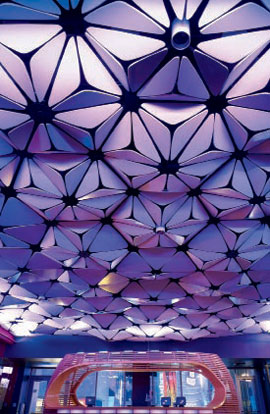
|
The ceiling's bold design lures visitors up a stairwell to the second-floor club (above). Light fixtures and sprinkler heads are hidden within the center of the ceiling's flower shapes (left). The straps used to tie each flower to the next must withstand a certain tolerance of rotation (below).
Photos: © Benny Chan |
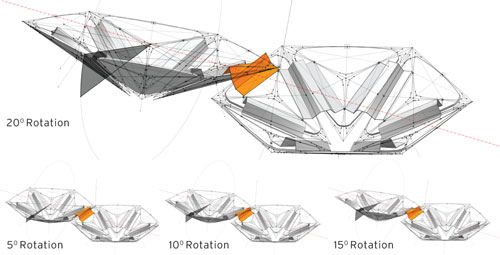 |
Â
In order to optimize sound absorption and vibration, the architects continually tweaked the overall look and curvature of the ceiling by focusing on the individual elements. "The ceiling design was always aesthetically driven," says Andrew Atwood, the project manager for the ceiling millwork, who worked closely with acoustical engineer Martin Newson during the nine-month design process. The diamondshaped panels of the tornado and entry sequence-many of which are unique-morph into "flowers" over the dance floor, where acoustical concerns are greatest. While there are only three panel shapes in this main part of the ceiling, the flowers vary greatly according to the arrangement of their petals, and the angle at which the petals are hung. These variables allow the ceiling's acoustics to be controlled based
on density and porosity. Using the acoustical-simulation application in Ecotect, a building design and environmental analysis tool by Autodesk, they were able to calibrate the different ceiling porosities and locate zones that needed adjusting to enhance acoustics. The quantitative data extracted from Ecotect informed a sophisticated parametric model. Those parameters were plugged into a series of scripts with Excel spreadsheets, and finally into a digital model and fabrication drawings using Rhino. "When we worked on Patina in 2003, we really challenged digital fabrication," Belzberg recalls. "Since then, we've fallen in love with the process."
Multiple lighting, audiovisual, mechanical, and fire-and life-safety systems, among others, had to be considered during the design process. The final three-dimensional model was able to accept information and constraints from many constituencies, including the acoustical and m/e/p engineers, and LED-lighting specialists, creating a series of feedback loops that were reflected and translated directly to fabrication templates for output to the ceiling's installers.
 |
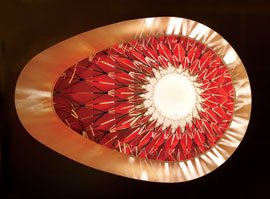
|
An LED lighting system allows the Conga Room's ceiling to change color at the push of a button, and can react to the rhythms of the music on the dance floor (top and left). An exploded axonometric illustrates the ceiling's multilayered assembly (below).
Photos: © Benny Chan |
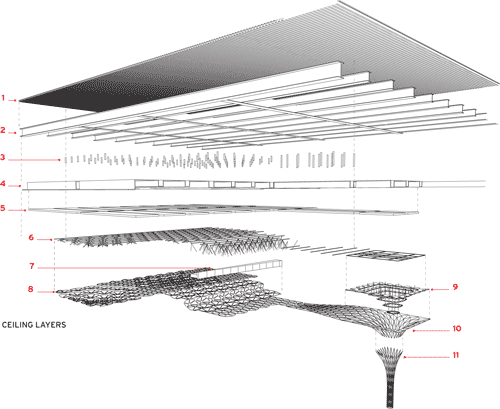
1. Composite deck
2. Structural beams
3. Sound-isolating posts
4. Gypsum-board wrap
|
5. Acoustical blanket
6. Unistrut system
7. HVAC duct
8. Ceiling petals |
9. Structural rings
10. Tornado plywood panels
11. Tornado acrylic panels |
|
Â
But the parametric models did have their limitations. "At some point, there were almost a dozen different consultants working on the project," Atwood says. "Since they couldn't always visualize what we were doing, we had to build a physical model, specifically of the tornado. It reassured them that the design wasn't as complicated as they originally thought when just looking at the drawings."
The ceiling's many layers incorporate a number of elements. House lights and sprinkler heads are conveniently located within the central circle of the ceiling flowers. Tracks hung below the flowers house a multicolored LED lighting system that directs light onto the petals. The designers again used Ecotect to study lighting levels at every petal. In order for the light to be uniformly distributed across the ceiling surface, the tracks had to adjust to the shape of the ceiling. The surface inflection at the back of the space required the lighting system to bend in plan as well as in section to maintain the desired lighting quality.
The architects chose to attach the flowers, which average almost 6 feet in diameter, to metal wires that hang from a Unistrut framing system. Each flower was constructed inside a hexagonal plywood jig that was designed to accommodate the varying petal angles. A metal strap ties each petal to the next. In order for each flower to maintain its shape, the straps had to withstand a certain tolerance of rotation. Predictive modeling of material behavior took into account the elastic deformation of the metal strap and set the limit each flower could rotate in relation to its neighbors.
Acoustically wrapped structural beams, ductwork, and additional acoustical treatments, including sound-isolating posts and an acoustical blanket, are layered above
and below the framing system, but well-hidden by the ceiling flowers. Assembly of the tornado was somewhat different, and relied on CNC milled plywood structural ribs that are hung by rods off the Unistrut system. "Many of the interiors we work on are 90 percent complete when we get them," Belzberg says. "So doing large, articulated surfaces requires us to get the sculpted effect outside the space."
Spectrum Oak in nearby Orange, California-the same shop that created Belzberg's design for the large, sculpted elements in the Patina Restaurant-milled the Conga Room's plywood panels. While the milling itself was completed within a week or two, installation of the panels took a little longer. "Once the installers started hanging the panels, there was another recalibration that took place," recalls Atwood.
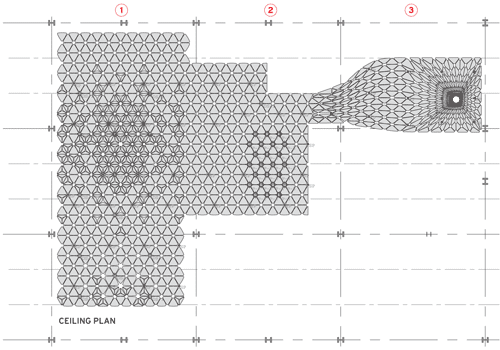
1. Main dance hall
|
2. Entry hall |
3. Tornado |
|
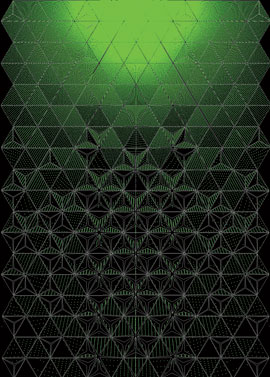
|
The club's layout is divided into three parts (above). The glowing, 20-foot-tall tornado penetrates the floor slab below it (bottom). Acoustical simulation programs were used to determine the ceiling�s porosity (left).
Photo: © Benny Chan |
 |
Â
Installers suspended the ceiling panels in the main space according to a grid. As each row was hung from the Unistrut system, the architects would check that all of the various elements-panels, sprinkler heads, ductwork, framing-were coming together as planned. If something needed to be shifted, or an alteration of a panel was necessary, much of that could be done on-site.
For the uniquely shaped panels of the tornado, where tolerances were not as great as in the rest of the ceiling, alterations required an additional step. Atwood was able to make changes in the parametric model for a handful of tornado panels based on measurements taken on-site, immediately sending the modified information
from his laptop to the fabricators so that they could produce new versions. "We input the information in the model, then e-mailed the Rhino file to the shop," explains Atwood. "The new panels were cut, painted, and delivered to the site the next morning. It worked surprisingly well, much better than anyone anticipated."
Across the globe in Vienna, Austria, another pioneering young architecture firm was using CNC milling to experiment with wall surfaces. Lilli Pschill and Ali Seghatoleslami, founding partners of PSA Architects, were hired to renovate expanded law offices inside a traditional, turn-of-the-20th-century Viennese building-traditional except for one unmissable element. Instantly recognized from the exterior, the building houses Coop Himmelb(l)au's radical rooftop addition
of exploding glass and steel, an iconic architectural work completed 20 years earlier for the same client.
PSA's intervention is located on the building's second floor, one half of which contained a run-down apartment, and the other half, already refurbished offices. According to Pschill, "The main purpose of our project was to unite the two halves of the floor." Given its brave client, PSA turned a functional challenge into an aesthetic tour de force.
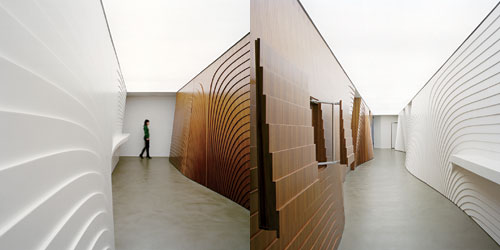 |
The law offices' 9-foot-wide corridor is flanked by sculptural wall elements, parts of which
curve out up to 2 feet. One side is composed of white Corian panels, the other walnut. A seamless ceiling and uniform floor keep attention focused on the walls (top). |
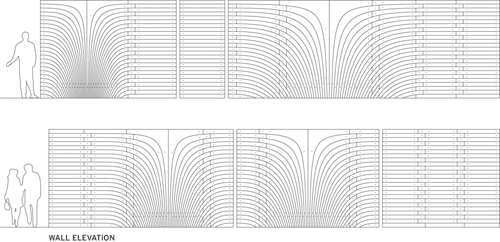 |
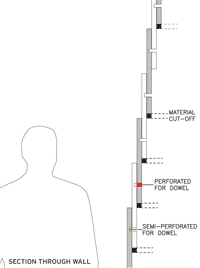
|
Elevations illustrate the sinuous, two dimensional layout of the wall panels (above). The positioning of the panels relied on an array of predrilled dowels (left).
Photo: © Hertha Hurnaus |
Â
They did so by articulating the long connecting corridor that spans those two areas. At 9 feet wide and nearly 60 feet long, the architects envisioned the corridor as more than just a circulation space. "We thought it could be used in a much more advantageous way, where people could have coffee or gather during a break in a meeting," Pschill says. "That's why we came up with these curving walls. They are like curtains that move you through the space and pull you into the conference
rooms and offices that surround it."
Similar to a curtain, the walls are straight along the top edges to form a perfectly rectangular ceiling. A scrim conceals fluorescent light fixtures to create a luminous covering over the corridor. A cement based material-which extends beyond the field of the corridor to connect all adjacent spaces-gives the floor a continuous finish. These flat, seamless elements keep attention focused on the sculptural walls, which curve out up to 2 feet at the lower portions as they swerve along the floor. For functional reasons, a 3/4-inch gap separates the walls from both the ceiling and the floor.
Like Belzberg, PSA turned to a local shop with a CNC mill to fabricate the panels in a week's time. The panels of one wall are composed of 1/2-inch-thick white Corian, while slightly thinner, walnut laminated-plywood panels make up the darker, opposite wall.

1. Offices
2. Bar
3. Conference room
|
4. Stairs
5. Elevator |
 |
|
Â
"The form came first, then we had to figure out how to make it," Pschill recalls. PSA designed the three-dimensional form in Rhino, but it was the appearance of the lines on the two-dimensional wall elevations that inspired the firm to slice the bulging surfaces into layers, or sediments, that run parallel to the wall itself and overlap each other. The architects call their finished walls "structural ornament." Within that ornament, they concealed infrastructure, electrical panels, and a thermostat, while incorporating a refrigerator, coffee bar, pull-out cabinets, a long shelf (made from CNC-milled, heat-molded Corian), and a flat-screen television, making a reality of PSA's vision of the corridor as a lively gathering space.
Installation of the panels and accompanying elements was not nearly as complicated as their intricate assembly might suggest. The almost 550 curving panels contain 2,550 predrilled holes for dowels-also executed by CNC machines-that attach one panel to the next. "Because of the predrilled dowel locations, the panels were self-positioning," Pschill explains. "When the installers came on-site, they just had to stick the pieces together. It would have been impossible without the CNC milling."






















